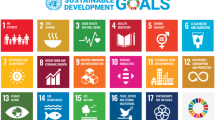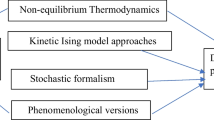Abstract
This article is an attempt to share the author’s experience of teaching electrochemistry at an individualized level. In addition to lectures and seminars, it is proposed to solve individually the problems based on experimental data published in the literature. The thought-provoking problems should be less straightforward and even less exact. To illustrate the approach, theory–experiment interactions are considered and exampled by an electrostatics-based model for the electron transfer elementary step. Two particular problems are presented as illustrations. Possible solutions, typical students’ mistakes, and misunderstandings are discussed step-by-step. This pedagogical approach is quite suitable for applied electrochemistry as well. It is time-consuming, but the author cannot imagine any alternative approach to generate qualified electrochemists for the future.



Similar content being viewed by others
References
Scholz F (2023) Electrochemistry and education. J Solid State Electrochemistry, in press,. https://doi.org/10.1007/s10008-023-05586-8
Tsirlina G (2020) Evolution of electrochemical education. J Solid State Electrochem 24:2679–2684. https://doi.org/10.1007/s10008-020-04752-6
Compton RG, Sokolov SV (2023) Electrochemistry needs electrochemists: “goodbye to rotating discs.” J Solid State Electrochemistry, in press,. https://doi.org/10.1007/s10008-023-05443-8
Akbashev A (2023) Electrochemical colloquium and beyond: opportunities for online education in electrochemistry. In: Abstracts 243rd ECS Meeting, L01–2432
Frumkin A (1933) Wasserstoffüberspannung und Struktur der Doppelschicht. Z Phys Chem A 164A:121–133. https://doi.org/10.1515/zpch-1933-16411
Frumkin A, Nikolaeva-Fedorovich NV, Berezina NP, Keis KE (1975) The electroreduction of the S2O82- anion. J Electroanal Chem 58:189–201. https://doi.org/10.1016/S0022-0728(75)80352-4
Frumkin AN, Florianovich GM (1951) Elektrovosstanovlenie anionov [Electroreduction of anions]. Doklady AN SSSR 80:907–910 (in Russian)
Frumkin AN, Petry OA, Nikolaeva-Fedorovich NV (1963) On the determination of the value of the charge of the reacting particle and of the constant α from the dependence of the rate of electro-reduction on the potential and concentration of the solution. Electrochim Acta 8:177–192. https://doi.org/10.1016/0013-4686(63)80018-3
Tsirlina G (2017) The role of supporting electrolyte in heterogeneous electron transfer. J Solid State Electrochemistry 21:1833–1845. https://doi.org/10.1007/s10008-017-3669-1
Gierst L, Cornelissen P (1960) L’influence de la nature et de la concentration de l’électrolyte-support sur la morphologie des ondes polarographiques du système EuII-EuIII. Collect Czech Chem Commun 25:3004–3015. https://doi.org/10.1135/cccc19603004
Asada K, Delahay P, Sundaram AK (1961) Local field effect and failure of the double layer correction in electrode kinetics. J Amer Chem Soc 83:3396–3400. https://doi.org/10.1021/ja01477a010
Gavaghan DJ, Feldberg SW (2000) Extended electron transfer and the Frumkin correction. J Electroanal Chem 491:103–110. https://doi.org/10.1016/S0022-0728(00)00210-2
Erdey-Gruz T, Volmer M (1930) Zur Theorie der Wasserstoff Überspannung. Z Phys Chem A 150:203–213. https://doi.org/10.1515/zpch-1930-15020
Guidelli R, Compton RG, Feliu JM, Gileadi E, Lipkowski J, Schmickler W, Trasatti S (2014) Definition of the transfer coefficient in electrochemistry (IUPAC Recommendations 2014). Pure Appl Chem 86:259–262. https://doi.org/10.1515/pac-2014-5025
Delahay P (1965) Double layer and electrode kinetics. Interscience-Wiley, New York
Russel CD (1963) Charge and outer Helmholtz potential for a mercury electrode in aqueous NaF at 25°. J Electroanal Chem 6:486–490. https://doi.org/10.1016/0022-0728(63)80180-1
Petrii OA, Nazmutdinov RR, Bronshtein MD, Tsirlina GA (2007) Life of the Tafel equation: current understanding and prospects for the second century. Electrochim Acta 52:3493–3504. https://doi.org/10.1016/j.electacta.2006.10.014
Kuznetsov AM, Nazmutdinov RR, Schmickler W (2002) Monte Carlo simulation of electrochemical electron transfer processes. J Electroanal Chem 532:171–180. https://doi.org/10.1016/s0022-0728(02)00982-8
Zagrebin PA, Tsirlina GA, Nazmutdinov RR, Petrii OA, Probst M (2006) Corrected Marcus plots. J Solid State Electrochem 10:157–167. https://doi.org/10.1007/s10008-005-0058-y
Mishchenchuk VV, Nechyporuk VV, Tkachuk MM, Yuz‘kova VD, (2013) Mathematical modeling of nonequilibrium behavior of electrochemical systems with the electroreduction of anions. Electrochim Acta 108:153–166. https://doi.org/10.1016/j.electacta.2013.06.089
Pendergast AP, White HS (2023) Double-layer inhibition of peroxydisulfate reduction at mercury ultramicroelectrodes. a quantitative analysis of the Frumkin effect including molecular transport and long-range electron transfer. J Phys Chem C 127:11283–11297. https://doi.org/10.1021/acs.jpcc.3c01822
Hamzah HH, Aarons J, Shafiee A (2018) Review — electroreduction of peroxodisulfate: a review of a complicated reaction. J Electrochem Soc 165:H785–H798. https://doi.org/10.1149/2.1161811jes
Acknowledgements
The author is grateful to the Pause program for support.
Author information
Authors and Affiliations
Corresponding author
Additional information
Publisher's Note
Springer Nature remains neutral with regard to jurisdictional claims in published maps and institutional affiliations.
Rights and permissions
Springer Nature or its licensor (e.g. a society or other partner) holds exclusive rights to this article under a publishing agreement with the author(s) or other rightsholder(s); author self-archiving of the accepted manuscript version of this article is solely governed by the terms of such publishing agreement and applicable law.
About this article
Cite this article
Tsirlina, G.A. Theory–experiment interaction as a cornerstone of specialized electrochemical education: Invent your own less conventional problems. J Solid State Electrochem 28, 981–993 (2024). https://doi.org/10.1007/s10008-023-05725-1
Received:
Revised:
Accepted:
Published:
Issue Date:
DOI: https://doi.org/10.1007/s10008-023-05725-1




